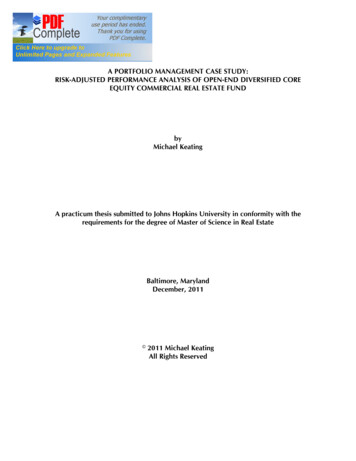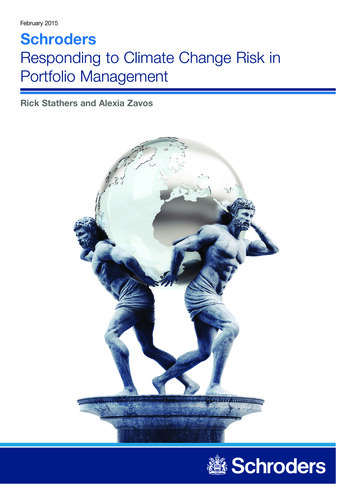
Transcription
A PORTFOLIO MANAGEMENT CASE STUDY:RISK-ADJUSTED PERFORMANCE ANALYSIS OF OPEN-END DIVERSIFIED COREEQUITY COMMERCIAL REAL ESTATE FUNDbyMichael KeatingA practicum thesis submitted to Johns Hopkins University in conformity with therequirements for the degree of Master of Science in Real EstateBaltimore, MarylandDecember, 2011 2011 Michael KeatingAll Rights Reserved
Table of ContentsSectionPage NumberI.Introduction1II.Real Estate Investment Strategies4III.Real Estate Fund Structures5IV.Open-end Diversified Core Equity Funds6V.Multi-Employer Property Trust9VI.MEPT Performance versus the Benchmark11VII.Risk14VIII.Risk-Adjusted Performance Metrics15IX.Summary of Risk-Adjusted Performance and Efficiency18X.Fund Characteristics that Enhance Efficiency21XI.Conclusions26Appendix A:List of MEPT Assets29Appendix B:NCREIF Regional Definitions32Appendix C:Works Cited33
I. IntroductionTo many, the concept of portfolio management conjures images of white-shoeinvestment managers toiling over portfolios of stocks, bonds, and perhapscommodities. A portfolio manager’s main objective is to manage a combination ofassets whose performance and risk are measured in aggregate. They seek to reducerisk for investors by diversifying a fund’s asset base, which reduces variability ofreturn (Staiger, 2011). To that end, the modern investment landscape has expandedthe portfolio management paradigm to include so-called alternative asset classessuch as hedge funds, private equity, and commercial real estate. Of the alternativeassets, commercial real estate in particular has started to shed its “alternative” labeland is becoming an essential part of a sophisticated manager’s portfolio analysis(Florance et al, 2010).Commercial real estate consists of properties that are owned to produce income,which is generated through rental payments and as such, the primary value of apiece of real estate is derived from its leases. However, commercial real estate isalso a tangible asset with intrinsic value and inflation hedge qualities. Directinvestment in commercial real estate has been an important strategic allocation forportfolio managers of endowments, foundations and pension funds for decades:they seek its potential for high income, stable total returns, and added diversificationto investment portfolios in volatile markets (Brooks, 2011). Also, commercial realestate offers attractive bond-like qualities in that it produces income through rents toproduce a yield that moves conversely with the underlying asset value.1
Investors typically employ commercial real estate as long duration asset.Commercial real estate is generally less liquid than other asset classes and has morepredictable cash flow characteristics due to the underlying lease structures. As such,commercial real estate is often an attractive investment option for groups that needto match or hedge against long duration liabilities such as insurance companies andpension funds.The below graph shows the annual returns for equities (S&P 500 Index), fixedincome (Barclays US Aggregate Bond Index), commercial real estate (NCREIFProperty Index), and residential real estate (Case-Shiller Index):Asset Class Returns30%20%S&P 500 Index10%Barclays US AggregateBond Index0%20062007-10%200820092010NCREIF Property IndexCase-Schiller-20%-30%-40%Source: Standard & Poors, Barclays, NCREIFWhen compared with other asset classes, commercial real estate’s annual returnshave demonstrated less volatility than equities and more volatility when comparedto fixed income and residential real estate. To achieve exposure to commercial realestate, fund managers typically invest in professionally managed real estate funds,which can have widely varying structures and investment strategies. Accordingly, it2
is prudent to approach commercial real estate investment with the same disciplineas other asset classes. For fund managers, selecting a commercial real estate fundcan pose difficulties. Due to the exceedingly idiosyncratic nature of commercial realestate investments, many focus on the property level returns such as income returnor internal rate of return (IRR). When focusing on individual property-level IRR’s andincome returns, it is easy to simply aggregate asset returns to generate portfolio-levelreturns, which is often used as a proxy for fund performance.Using aggregated asset returns to derive investment performance is an incompleteassessment because returns alone do not provide a measurement of risk. Accordingto Markowitz’s Modern Portfolio Theory, the most efficient portfolio is one thatmaximizes return given a certain risk tolerance (Markowitz, 1959). That is, toanalyze the most efficient or best performing portfolio, one must analyze aportfolio’s risk-adjusted performance metrics. Markowitz’s methodology has beenapplied for years to traditional investment portfolios and since real estate is now astandard component of a modern investment portfolio, it is logical that it too shouldbe analyzed with the same analytical discipline provided by Markowitz. Using theMulti-Employer Property Trust (“MEPT”), an open-end institutional real estate fund,as a case study, this paper will endeavor to analyze the risk-adjusted performancemetrics of a commercial real estate portfolio to calculate investment efficiency. Afterassessing investment efficiency, this paper will identify commercial real estateportfolio characteristics that are accretive or dilutive to efficiency.3
II. Real Estate Investment StrategiesWith real estate assets, there are two primary investment strategies: Core and NonCore. A core strategy involves a conservative approach to real estate investment andthe subject of this case study, MEPT, is a core fund. Core funds are generallycharacterized as focusing on: 1) major property types (office, apartments, industrial,and retail); 2) assets with steady cash flow and strong tenant rosters; 3) newer,functionally superior assets; 4) assets located in primary investment markets; and 5)assets that are highly liquid. By way of example, below are comparative pictures ofa core and non-core multifamily building:Core:Enso Pearl District, Portland, OregonNon-Core:One Jefferson Apts., Lake Oswego, OregonThe core building is modern, urban asset that was recently completed while thenon-core asset is an older suburban asset constructed with inferior materials. A noncore strategy employs a more aggressive approach to real estate investment andconsists of three subsets:4
I. Core Plus: This is a moderate risk/moderate return strategy and involvesinvesting in borderline core properties that require some form ofenhancement or value-added element (McDonald & Stiver, 2004).II. Value-added: This is a medium-to-high risk/medium-to-high returnstrategy. Generally, it involves buying a property, improving it in somemanner, and selling it at an opportune time for a gain. Properties areconsidered value-added when they exhibit management or operationalproblems, require physical improvement, and/or suffer from capitalconstraints (McDonald & Stiver, 2004).III. Opportunistic: This is a high risk/high return strategy. The propertiesrequire a high degree of enhancement. This strategy may also involveinvestments in development, raw land, and niche property sectors(McDonald & Stiver, 2004).III. Real Estate Fund StructuresIn the institutional real estate world there are generally two types of funds: closedend funds and open-end funds. A closed-end fund is a collective investment schemewith a limited number of shares and is a popular structure for private equity funds. Itis called a closed-end because new shares are rarely issued once the fund haslaunched, and because shares are not normally redeemable for cash or securitiesuntil the fund liquidates (www.sec.gov, n.d.). A closed-end fund is launched after aninitial capital raising stage. After the capital raise, these funds typically have a ten5
year life span consisting of a 2-3 year investment period during which properties areacquired followed by a holding period during which active asset management willbe carried out and the properties will be sold (McDonald & Stiver, 2004).As for open-end funds, most people are familiar with this structure by way of mutualfunds and the subject of this case study, MEPT, is an open-end fund. As the nameimplies, open-end funds can issue and investors can redeem shares withoutliquidation of the fund itself, which is facilitated by periodic valuations. For openend real estate funds, the periodic valuation is typically on a quarterly basis andconsists of a third-party appraisal of each property within the portfolio. Throughthese individual valuations, an open-end fund is then able to assess its net assetvalue, which is then used to calculate share value. In contrast to close-end funds,open-end funds are a more convenient real estate investment vehicle for PortfolioManagers due to their liquidity. The ability to invest and withdraw from a real estateinvestment on a quarterly basis allows for more efficient management of adiversified investment portfolio.IV. Open-end Diversified Core Equity FundsMEPT is both core and open-ended; as such, MEPT belongs to a universe of peerfunds known as the Open-end Diversified Core Equity (ODCE) funds. The ODCEpeer group was created by the National Council of Real Estate InvestmentFiduciaries (NCREIF). NCREIF is a not-for-profit trade association that serves itsmembership, and the academic and investment community's need for improved6
commercial real estate data, performance measurement, investment analysis,information standards, education, and peer group interaction (ncreif.org, n.d.).NCREIF tracks the performance of these funds through an index known as the NFIODCE (“ODCE”), which tracks the historical and current investment returns of 26open-end funds pursuing a core strategy (ncreif.org, n.d.). In addition to being openended and pursuing a core strategy, ODCE funds must also follow the belowguidelines provide by NCREIF:Net Assets Criteria:Real Estate - at least 80% of the market value of net assets must be investedin real estate with no more than 20% invested in cash or equivalents.Real Estate Net Assets Criteria:·Investment - at least 80% of the market value of real estate net assetsmust be invested in private equity real estate properties. No more than20% of such assets may be invested in, but not limited to, propertydebt, public company, equity/debt or private company (operatingbusiness) equity/debt.·Domain - at least 95% of market value of real estate net assets must beinvested in US markets.·Property Types - at least 80% of market value of real estate net assetsmust be invested in office, industrial, apartment and retail propertytypes.7
·Life Cycle - at least 80% of market value of real estate net assets mustbe invested in operating properties. No more than 20% of such ment/redevelopment or initial leasing/lease-up cycles.·Diversification - no more than 70% ( for market forces) of marketvalue of real estate net assets may be invested in one property type orone region as defined by the NPI.Total Assets Criteria:·Leverage - no more than 40% leverage. Leverage is defined as the ratioof total debt, grossed-up for ownership share of off-balance sheet debt,to the fund's total assets, also which are grossed-up for such off-balancesheet debt.In its historical data, the ODCE index includes 26 funds; however, the ODCE indexcurrently only includes 17 individual funds due to various fund liquidations andmerges. The current ODCE funds are listed on the following page:8
Net Asset Value – 2Q 2011 (in Billions) 0 2,000 4,000 6,000 8,000 10,000UBS TPF 9,326.5 9,189.1PRISA 5,931.5Morgan Stanley Prime 5,208.4RREEF 5,140.7MEPTPRISA II 4,634.2 3,517.0Principal 3,316.7Clarion Lion 3,016.0INVESCOBlackRockAmerican CoreJPMorgan SpecialASB Capital Management 14,000 14,132.1JPMorgan StrategicAFL-CIO BIT 12,000 2,113.0 1,868.3 1,784.5 1,623.4 1,471.4Cornerstone 1,062.2PRISA III 1,023.5Source: NCREIFThe total net asset value of the ODCE index as of the second quarter 2011 was 74.4 billion. MEPT was the 6th largest fund in terms of NAV with 5.14 billion innet assets.V. Multi-Employer Property TrustAs previously mentioned, MEPT is an open-end, core real estate equity fund. Thefund invests in a diversified portfolio of institutional-quality real estate assets acrossthe United States (mept.com, n.d.). MEPT was created in 1982 and was originally adevelopment-focused fund due to its targeted investor base: Taft-Hartley (i.e. union)pension plans. At inception, the fund attracted its investor base by offering jobcreation by means of development while providing investment exposure to realestate. Over the years, however, the fund has shifted from a development strategy9
to a core strategy wherein the fund primarily buys existing properties and developson a very selective basis (never more than 20% of fund NAV). As of the secondquarter 2011, MEPT consisted of 149 investments in 30 major metropolitan markets(see Appendix A for a list of all assets) and its property type concentration weightedby net asset value was as follows:Property 2%20%14%2%3%RetailIndustrialOtherSource: NCREIFWhen compared to the peer group, the most noticeable deviations in product typediversification were MEPT’s overweight to office and underweight to retail. Thebelow table details MEPT’s regional allocations versus the peer group as of the endof the second quarter 2011:Property West38%38%Source: NCREIFIn terms of regional diversification, MEPT is similar to the peer group in the East andWest; however, MEPT deviates from the benchmark in the South and Midwest as ithas a strong overweight in the Midwest and a strong underweight in the South.10
VI. MEPT Performance versus the BenchmarkAlthough MEPT has been active for almost 30 years, this case study will focus onperformance from 2001 to 2011. This time period was selected because the U.S.commercial real estate market experienced an entire economic cycle: the up-cyclefrom 2001–2007, the down-cycle from 2008-2009, and the modest recovery from2010-2011. The full cycle that occurred during the previous 10 years is shown inthe graph below, which illustrates commercial real estate pricing trends from 1984to the end of 2010:All-Property Price Index Level250TBI 1984Q1 100, NPI set to avg levelTBI200NPI yyyyqSource: MIT CREAs shown above peak relative pricing occurred in 2007 and was followed by asharp downturn in values in 2008 and 2009. Since the end of 2009, commercialreal estate pricing has experienced a modest recovery in values.11
The 1, 3, 5, and 10-year returns of MEPT as well as the ODCE peer group aredetailed in the table below:Fund NameTrailing 12month return3-yearReturn5-yearReturn10-year ReturnJPMorgan Strategic18.92%(6.22%)1.17%6.73%UBS )5.52%Morgan Stanley 4%)5.67%MEPT19.28%(7.98%)(0.17%)5.16%PRISA (0.77%)5.27%Clarion 0.18%n/aAFL-CIO 5.10%)n/aAmerican Core17.64%(8.00%)(0.58%)n/aJPMorgan Special28.19%(14.06%)(3.60%)4.05%ASB Capital %)0.37%n/aPRISA III29.49%(18.05%)(4.27%)n/aNCREIF- ODCE20.48%(7.67%)0.01%5.64%Source: NCREIFIn comparison to the NCREIF-ODCE benchmark returns, MEPT trails in the 1-yearby 1.20%, trails in the 3-year by 0.31%, trails in the 5-year by 0.18%, and trails by0.48% in the 10-year. The table on the following page further breaks down ODCEfund performance by assigning a ranking within the peer group of returns for eachtimeframe:12
ing*JPMorgan Strategic13333UBS TPF16112PRISA911116Morgan Stanley Prime11744RREEF3895MEPT12989PRISA II415147Principal817178Clarion Lion5121211INVESCO757n/aAFL-CIO BIT154510BlackRock101316n/aAmerican Core141010n/aJPMorgan Special2141312ASB Capital Mgmt.6221Cornerstone1766n/aPRISA III11615n/aFund Name*Includes only 12 fundsWhen looking at 1-year returns, MEPT is ranked 12th out of 17 funds. In the lastyear, commercial real estate experienced a significant recovery in values. ODCEfund returns ranged from 16.7% to 29.5% and the benchmark return was 20.48%,which implies that MEPT trails the peer group average during up-cycles. On theother hand, MEPT ranked 9th in the 3-year and 8th in the 5-year returns, which isright at the median for the peer group. These timeframes include both the recentrecovery as well as the sharp downturn caused by the financial crisis of 2008 (seegraph on page 9). As such, MEPT’s relative return improves when factoring in adown-cycle. However, using the above return comparisons to analyze MEPT’s13
“performance” is an incomplete measurement - one must also consider a fund’s riskadjusted performanceVII. RiskWhat exactly is risk-adjusted performance? In the investment context, risk is theunexpected variability or volatility of returns and thus includes both potential worsethan-expected as well as better-than-expected returns (Horcher, 2005). Asmentioned before, a portfolio manager seeks to reduce variability. The mostoverlooked aspect of this definition is the concept of “better-than-expected” returns.That is, low risk implies that the variability of expected returns is limited and assuch, an investment is not necessarily less risky simply if it has lower downsidereturn expectations; outsized upside returns also means more risk. Risk can bequantified as variance and standard deviation about an expected outcome or asample mean (Staiger, 2011). For illustrative purposes, the graph below depicts risk:14
X-Bar represents the expected outcome and the spread or dispersion of the bellcurve represents the variability of expected outcomes (risk).VIII. Risk-Adjusted Performance Metrics1) RangeThere are several ways to estimate risk, but the simplest method is Range, which isthe distance from largest to highest value. When looking at MEPT’s 1, 3, 5, and 10year returns, the range of returns is 27.26%. Below is a comparison of MEPT’s rangeversus the ODCE peer group:Fund NameRange ofReturnsFund Ranking(low to high)JPMorgan Strategic25.14%4UBS TPF20.75%1PRISA31.33%10Morgan Stanley Prime26.84%6RREEF35.48%12MEPT27.26%7PRISA II41.47%15Principal30.12%8Clarion Lion38.55%14INVESCO31.50%11AFL-CIO BIT23.55%3BlackRock37.54%13American Core25.64%5JPMorgan Special42.25%16ASB Capital Mgmt.31.13%9Cornerstone23.39%2PRISA III47.54%17NCREIF- ODCE28.15%-15
When comparing MEPT’s range of returns over the last 10 years against the peergroup, MEPT is ranked 7th out of 17 funds, which places it in the 2nd quartile.Additionally, MEPT has a smaller range than the ODCE benchmark range. A smallerrange indicates a lower risk profile; therefore, when looking at range only, MEPThas a lower risk profile than the average ODCE fund.2) Variance and Standard DeviationAnother method to analyze risk is Variance. In statistics, variance is the measure ofdispersion in a set of numbers (Anderson et al, 1995). Essentially, it measure how fara group of number is spread out. The formula for variance is:S2å (x - x )2(n - 1)iWhen comparing variance values, a lower value indicates that there is lessdispersion and therefore, lower risk. A third measurement of risk is standarddeviation, which is the positive square of variance (Anderson et al, 1995). Likevariance, it measures dispersion and low values indicate that the data points beinganalyzed are closer to the mean than higher values. Unlike variance, standarddeviation is expressed in the same units as the data (percentages for the purposes ofthis analysis); as such, it is often a preferred metric to variance. The standarddeviation formula is below:ss å(xi- x)2n -116
The variance and standard deviation calculations for MEPT and the ODCE peerfunds are detailed below:AverageReturns*VarianceStandardDeviationFund RankingJPMorgan Strategic4.62%0.016712.92%4UBS TPF6.68%0.010810.38%1PRISA3.74%0.026316.21%9Morgan Stanley T3.71%0.019714.04%7PRISA arion FL-CIO merican Core3.02%0.017413.19%5JPMorgan Special3.51%0.048422.00%16ASB Capital 9%2PRISA III2.39%0.059824.46%17NCREIF- ODCE4.27%0.021214.55%-Fund Name*Average of the 1, 3, 5 year returnsSimilar to the results of the Range calculation, MEPT is the 7th ranked fund in termsof variance and standard deviation, both better than the ODCE benchmark. Also, itis important to note that MEPT’s average return over the 1, 3, and 5-year timeframesis lower than the ODCE average by 0.56%. According to the above table, MEPT hasa lower risk profile (smaller variance), but lower returns in comparison to the ODCEbenchmark.17
IX. Summary of Risk-Adjusted Performance and EfficiencyTo summarize, below is a table detailing MEPT’s comparative rankings in terms ofreturn and risk metrics:Peer GroupRankingMulti-Employer Property TrustReturn Metrics:1- year Return3- year Return5- year Return10- year ReturnRisk Metrics:Range of ReturnsVariance of ReturnsStandard Deviation of 14.04%777*Includes only 12 fundsMEPT is below-average in terms of returns as it consistently ranked in the thirdquartile of the peer group in the 1, 3, 5 and 10-year timeframes. However, whenconsidering the risk metrics, MEPT is consistently in the second quartile as it ranks7th out of 18 funds in the range, variance, and standard deviation of its returns.MEPT realized lower relative returns, but had lower relative risk.To further summarize the results of the risk metrics, the table on the following pagecompares the ODCE funds’ risk ranking (in terms of variance and standarddeviation) and return ranking:18
Standard Deviation RankingAverage ReturnsRanking*JPMorgan Strategic43UBS TPF11PRISA911Morgan Stanley Prime64RREEF129MEPT78PRISA II1514Principal817Clarion Lion1412INVESCO117AFL-CIO BIT35BlackRock1316American Core510JPMorgan Special1613ASB Capital Mgmt.102Cornerstone26PRISA III1715Fund Name*Average of the 1, 3, 5 year returnsBy simply looking at the rankings for risk and return above, it is difficult to discern arecognizable pattern of relative risk-adjusted performance. However, by calculatinga fund’s efficiency – the ratio of risk and return – one can determine which fundsmaximize return for a given risk level and therefore, maximize performance. Acomparable efficiency metric can be produced by dividing standard deviation (theproxy for risk) by the average return. The most efficient or best performing fundshave a lower efficiency value on account of having a relatively low numerator (risk)and a relatively high denominator (return). The table on the following page showsthe efficiency values for each fund:19
StandardDeviationAverageReturns*EfficiencyFund RankingJPMorgan Strategic12.92%4.62%2.804UBS TPF10.38%6.68%1.551PRISA16.21%3.74%4.3311Morgan Stanley 4%3.71%3.7810PRISA n O ican Core13.19%3.02%4.3712JPMorgan Special22.00%3.51%6.2715ASB Capital ISA III24.46%2.39%10.2316NCREIF- ODCE14.55%4.27%3.41-Fund Name*Average of the 1, 3, 5 year returnsIn terms of efficiency, MEPT drops back to 10th in the peer group versus its riskranking of 7th and was below the ODCE median. There were several funds that hadhigher risk levels, but better efficiency than MEPT. For example, RREEF had astandard deviation of 18.73%, which ranked 12th in the peer group, but had anefficiency ranking of 5th. Another example was ASB, which had a standard deviationrank of 10th, but an efficiency ranking of 2nd. To better understand why certain fundshave better efficiency, it is prudent to examine the specific characteristics of eachfund.20
X. Fund Characteristics that Enhance EfficiencyAll ODCE funds follow similar general core investment strategies; however, eachfund has a unique portfolio and, as demonstrated above, has distinctive risk andreturn profiles. There are three main macro-level ways that ODCE funds candistinguish their portfolios – regional diversification, property type diversification,and fund leverage. As such, the below analysis will attempt to uncover patterns inthese characteristics that correlate with portfolio efficiency.1) Geographic DiversificationNCREIF defines four distinct geographic regions: East, South, Midwest, and West(see Appendix B for regional descriptions). As of the 2nd quarter 2011, the regionalallocations for the ODCE funds were as follows:EastMidwestSouthWestEfficiencyRankJPMorgan Strategic29%6%23%34%4UBS TPF39%10%28%38%1PRISA42%6%20%32%11Morgan Stanley 10PRISA II43%4%16%36%14Principal22%12%23%43%9Clarion BlackRock28%4%22%46%17American Core33%8%25%34%12JPMorgan Special45%8%20%36%15Fund NameAFL-CIO BIT21
ASB Capital Mgmt.n/an/an/an/a2Cornerstone38%8%5%48%8PRISA III40%3%33%24%16NCREIF- ODCE36%8%18%38%-Source: NCREIFWhen analyzing the regional allocations and efficiency rankings, no meaningfulpatterns emerge that correlate with high or low risk. For example, UBS TPF andINVESCO (1st and 3rd respectively in efficiency rank) have differing allocationpercentages in all regions. MEPT exactly matches the benchmark in the East andWest, but has an over-allocation to the Midwest and under-allocation to the South.The only real pattern that emerges is that all funds generally have similar allocationpercentages to the NCREIF-ODCE benchmark. In fact, the largest single deviationfrom the benchmark is PRISA III’s allocation to the South, which is only 15percentage points higher than the ODCE average. The above data indicates thatefficiency is not directly influenced by regional allocation alone and as such, onemust look at other fund characteristics such as property type diversification.2) Property Type DiversificationNCREIF categorizes properties into five different groups: Office, Industrial, Retail,Multifamily, and Other. The Other category within the ODCE peer group primarilyconsists of hotels; however, it also includes land, parking garages, senior housing,and self-storage. The table on the following page details the property typediversification of each fund:22
nkJPMorgan Strategic42%14%20%26%0%4UBS TPF27%10%23%33%7%1PRISA35%13%20%25%8%11Morgan Stanley %8%21%2%10PRISA II39%0%22%19%21%14Principal22%12%23%18%4%9Clarion /an/an/a7BlackRock37%15%23%25%0%17American Core39%16%22%22%0%12JPMorgan 5%14%17%27%7%8PRISA III31%0%17%20%32%16NCREIF- ODCE35%14%22%26%3%-Fund NameAFL-CIO BITASB Capital Mgmt.Source: NCREIFThe product type diversification figures start to reveal a pattern for funds with highand low efficiency. The top 5 funds in terms of efficiency (excluding ASB CapitalManagement, which has no property type data) have an average property typeallocation to Other and Multifamily of 30.8%. Conversely, the bottom 5 funds interms of efficiency have a much higher allocation to Other and Multifamily. Thesebottom performers had an average property type allocation to Other andMultifamily of 43.6%.The data above also suggests that an allocation to Other and Multifamily that is toolow can also dilute efficiency. MEPT has a below-median efficiency rank of 10th and23
an allocation to Other and Multifamily of 23%. Similarly, the 9th, 11th, and 12thranked funds have an average allocation to Other and Multifamily of 25.7%. Thispattern suggests that an optimal allocation to Other and Multifamily is around 30%;allocations that are materially higher or lower can negatively affect efficiency. Thisis due to the relatively volatile return characteristics of Other and Multifamily. Toohigh an allocation involves too much risk and too low an allocation forgoes higherreturns. The below table shows the 1, 3, and 5-year returns for all property typeswith Hotels being used as a proxy for Other:Source: NCREIFAs the table above shows, Multifamily has the highest 1-year return, which providesthe return “boost.” At the same time, Multifamily had the highest variability ofreturns (standard deviation); however, this was due to higher 1-year or up-cyclereturns. Hotel had the second highest standard deviation of returns. Moreover, theadditional property types in the Other classification include land, parking garages,senior housing, and self-storage. While there is limited performance data for theseproperty types, the anecdotal evidence of the volatility of these product types is thatthey are non-core and as mentioned previously, non-core investments take greaterrisk in attempts to achieve greater return. As the table above indicates, funds that areover-allocated to Other and Multifamily will experience greater volatility in overallreturns and funds that are under-allocated are denied a higher concentration ofaccretive returns.24
3) Fund LeverageLeverage (or debt) increases the risk or volatility of a real estate investment. Quitesimply, leverage is a technique to multiply
the portfolio management paradigm to include so-called alternative asset classes such as hedge funds, private equity, and commercial real estate. Of the alternative assets, commercial real estate in particular has started to shed its alternative label and is becoming an essential part of a sophisticated manager ˇs portfolio analysis (Florance et al, 2010). Commercial real estate consists .











